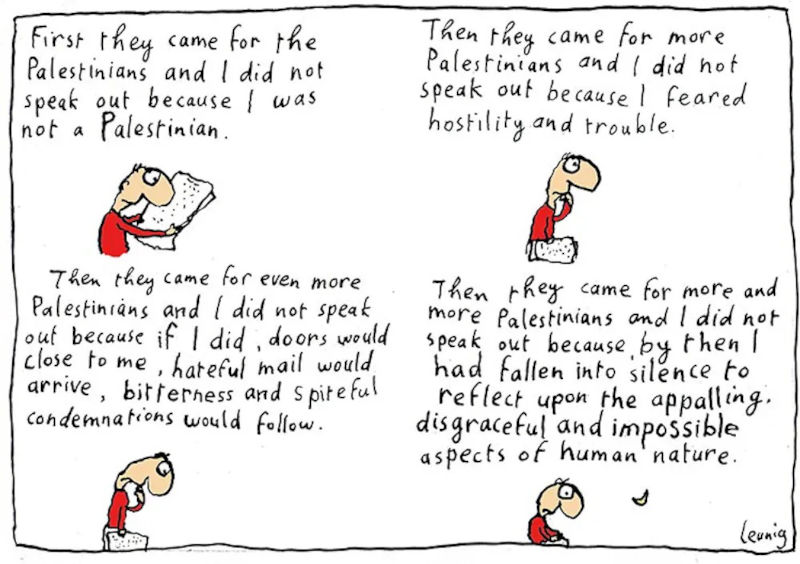Leunig cartoon: Antisemitism or valid political comment?
August 21, 2025
This article was originally published in The Age in November 2012. The republishing of the Leunig cartoon in Pearl and Irritations brought my article to mind.
On 21st November 2012, The Age published a cartoon by Michael Leunig which commented on the Israeli-Palestinian conflict. Leunig used a parody of the famous poem composed by Lutheran Pastor Martin Niemöller about the need to be vocal when one sees a wrong – even if not directly affected by it.
First they came for the communists, and I didn’t speak out because I wasn’t a communist.
Then they came for the trade unionists, and I didn’t speak out because I wasn’t a trade unionist.
Then they came for the Jews, and I didn’t speak out because I wasn’t a Jew.
Then they came for me, and there was no one left to speak for me.
There are variations to the poem and it seems it was first used in speeches Niemöller gave in 1946.
In Leunig’s cartoon, there are four frames to match the four stanzas of the original poem:
First they came for the Palestinians and I did not speak out because I was not a Palestinian.
Then they came for more Palestinians and I did not speak out because I feared hostility and trouble.
Then they came for even more Palestinians and I did not speak out because if I did, doors would close to me, hateful mail would arrive, bitterness and spiteful condemnations would follow.
Then they came for more and more Palestinians and I did not speak out because, by then, I had fallen into silence to reflect upon the appalling, disgraceful and impossible aspects of human nature.
There is an almost universal view in the leadership of the Victorian Jewish community that Leunig’s cartoon is antisemitic. The media release from the B’nai B’rith Anti-Defamation Commission quoted chairperson Dr Dvir Abramovich presenting the following arguments to support that claim.
“‘First they came…’ introduces a celebrated statement attributed to German pastor Martin Niemöller about the apathy of German intellectuals following the Nazi rise to power and their gradual elimination of certain groups. ‘They’, of course, referred to the Nazis. In Leunig’s cartoon, however, it is the Israelis who are the Nazis.
“And Leunig’s second antisemitic theme? That anyone who supports the Palestinians will immediately be besieged by the all powerful Jewish lobby, similarly jackbooted, treading on all who oppose them, closing doors in their faces, spiteful, hateful and bitter. In Leunig’s black and white world, Palestinian/Arab/Muslim lobby groups are muzzled and The Age would never dare to publish an article (or cartoon) critical of Israel.”
My reaction to the cartoon was very different. The power of a cartoon is in the many ways in which it can be interpreted. Once the cartoon is in the public domain it lives its own life – as indeed does Niemöller’s poem. My comments should therefore be understood to reflect a personal view.
That Leunig comes to his cartoon with the perspective of a Palestinian supporter merely sets the scene. The baseline of the cartoon is that Palestinians are always the victims. We know this isn’t a universal truth, but the cartoon isn’t a balanced dissertation on the Israeli Palestinian conflict – it’s a cartoon. It uses exaggeration to tell us something.
The parody of Niemöller’s language is playful: “First they came for the Palestinians . . . Then they came for more . . . Then they came for even more . . . etc.”. And in this respect Leunig can be criticised – or maybe he is being self-critical. Is he being too playful about the plight of the Palestinians in complaining overtly about silence as a form of tacit acceptance and covertly that publicly criticising Israeli treatment of Palestinians will be met with anger – from the Jewish community and “the all powerful Jewish lobby” to quote Dr Abramovich?
However the cartoon is also clever, because the reaction of the Jewish community, as articulated in the ADC media release, is in fact encapsulated within the cartoon. As Leunig said, “bitterness and spiteful condemnations would follow”, duly obliged by Dr Abramovich in his comments about the “ugly, simplistic cartoon”.
And so the Jewish community has been wedged. A more thoughtful response might have been to silently reflect on the sometimes appalling and disgraceful level of the debate about the conflict – and not just from one side. But, the genuinely held perception of antisemitism mandated a public response.
The Jewish community is a wonderful community, but sometimes I wish it was a little less weighed down by its collective memory and a little more informed by it. Sigh.
Perhaps, in the end, we might ask whether the cartoon is really about the Israeli-Palestinian conflict, or in fact about the conflict between the Jewish community and Leunig. It’s all a question of perception and interpretation – the power of the cartoon.
Harold Zwier is on the committee of the Australian Jewish Democratic Society
The views expressed in this article may or may not reflect those of Pearls and Irritations.

